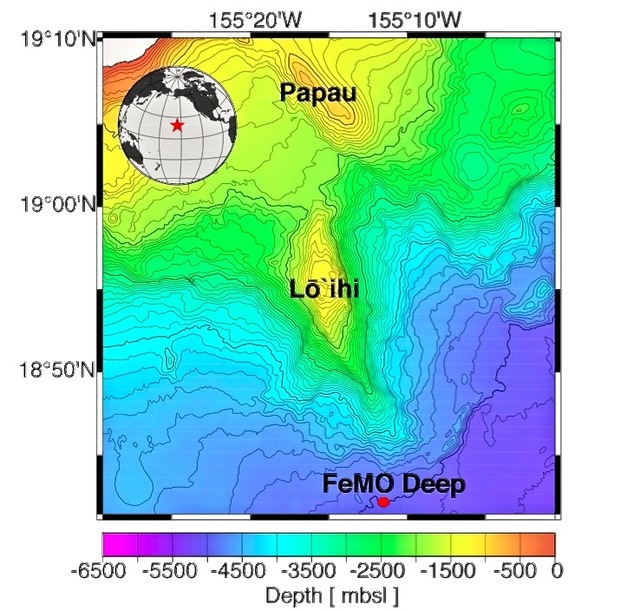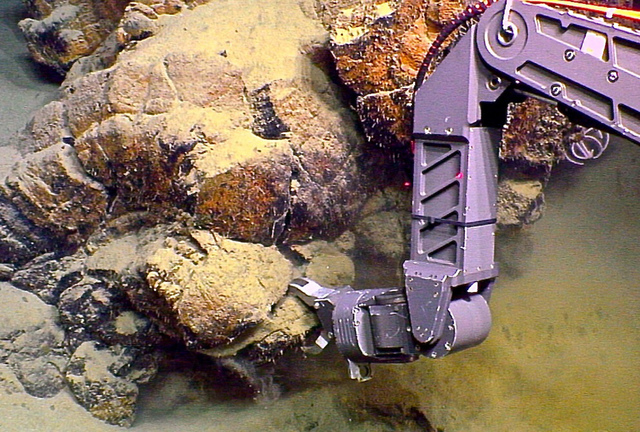Editor’s note: Over the next few weeks, West Hawaii Today will be taking a closer look at each of the volcanoes on and around Hawaii Island. This week is Loihi Seamount.
It may be 10,000 to 100,000 years before Hawaii’s smallest and youngest volcano breaches the surface of the ocean.
The Loihi Seamount, whose summit lies some 3,200 feet beneath the waves nearly 22 miles southeast of Ka‘u, was only discovered in 1952 when a flurry of earthquakes drew scientists’ attention offshore. The earliest known mention of Loihi was on bathymetric charts in 1940.
Loihi was given its Hawaiian name, which means “to extend, to be long,” in 1954 by Mary Pukui and Marha Hohuhe of Bishop Museum following an ocean floor survey, but no one seemed to give the underwater mound much thought until 1978, when, after a series of earthquakes, scientists were reminded of its presence and mounted a dredging expedition to explore more about what they thought was faulting under the sea. When the expedition turned up relatively new pillow lava, scientists knew they had something special.
“What distinguishes Loihi from other seamounts in the Hawaiian-Emperor seamount chain around the Hawaiian Islands is that all the others are dead. Loihi is capable of erupting, and therefore actually a young, emerging Hawaiian volcano, said University of Hawaii at Manoa professor of volcanology and Loihi geology expert, Michael Garcia.
Seismic monitors on land are far from Loihi’s watery flanks, and this makes precise monitoring of the seamount challenging and subject to a certain degree of imprecision. Still, the last confirmed eruption on Loihi was in 1996, and the most recent earthquake swarm — which could signal an eruption — was recorded a decade ago in 2005.
Should an eruption happen on the underwater volcano, Hawaii Island residents probably won’t even notice, said Garcia.
“It’s not likely given that the volcano is so deep. If it (an eruption) is long lived, maybe. The possibility of a tsunami caused by Loihi depends on what kind (and intensity) of earthquakes the eruption is producing,” he said, stressing a tsunami from Loihi is extremely unlikely.
Underwater eruptions, said Garcia, are only slightly different from ones that occur on land.
“The temperatures are much colder (because of the seawater and depth), and that slows things down slightly. There are fewer vesicles (bubbles in lava rock) on Loihi than at Kilauea,” he explained.
Studying 400,000-year-old Loihi has given scientists tremendous insight into how the other Hawaiian volcanoes have grown and progressed — the oldest Hawaiian volcanoes migrating northwest from the relatively fixed Hawaiian hotspot that created them all. This trend, noted Garcia in a 2005 invited review for a geochemistry journal, was also recognized by early Hawaiians as the pattern of fire goddess Pele, who “moved southward along the island chain with her fire causing successively younger eruptions to the south.”
While buzz about Loihi’s geology has been relatively quiet for the past 10 years, excitement continues to build around unique organisms that feed off the seamount’s iron-rich emissions. Only a few years ago, University of Hawaii scientists accidentally discovered large populations of iron-oxidizing bacteria thriving at Loihi’s base some 9,800 feet below the surface and far from the hydrothermal vents on its summit where they were previously only thought to exist.
University of Hawaii scientists are still analyzing data from a 2014 robotic mission to Loihi, undertaken in part to better understand the strange mats of creatures. Scientists think these bacteria could play an important role in balancing ocean chemistry, and might be responsible for some unexplained geological formations on Earth. Indicators of the presence of bacteria—iron deposits left in certain formations—could also be used as indicators could aid in future searches for life beyond Earth.
“It’s an exciting volcano. A new, active one that represents the early stages of the growth of each volcano that formed the Hawaiian Islands,” said Garcia. “There’s a lot we would still like to find.”









